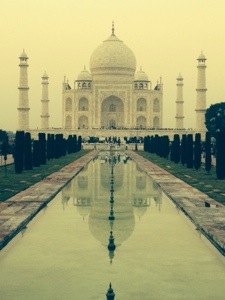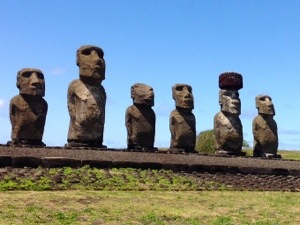
by Loti | Nov 24, 2013 | Architecture, Environment, India, Wonder of the World, World heritage Sites
India. Mark Twain, after visiting the Taj Mahal, said the world is split in two parts-those that have seen the beautiful monument and those that have not. I am now one of the lucky ones. Along with approximately 50,000 other visitors a day. Considered by many (including me) to be the most beautiful building in the world, this World Heritage Site is at risk of being damaged by modern pollution. Built in 1632 with no electricity, power tools, trucks or other modern day conveniences, it took 20,000 workers (building and crafting 24 hours a day) over 20 years to build. It completely boggles my mind! Yet in the last century, air pollution has been eating away at the white marble exterior and water pollution threatens the foundations on which the mausoleum is built. Pollution monitoring devices are everywhere, no gas powered vehicles are allowed within a half mile of the Taj Mahal and nearby coal based factories have been closed or converted to natural gas. But alas, all the pollution monitoring devices don’t work without electricity, which was off routinely for 6-10 hours a day due to power outages during our visit. And when the power is out, diesel generators kick on to supply power which just adds to the pollution. Old meets new. With no easy solutions, it is an interesting juxtaposition (my lexicon for the...

by Loti | Oct 15, 2013 | Architecture, Easter Island, Landscapes, Wonder of the World
Easter island. Remote does not even begin to describe this fascinating island. The closest inhabited island is Pitcairn Island with 50 inhabitants located 1300 miles away. Mainland Chile is over 2,100 miles, a 6 hour plane ride. Yet it boasts one of the longest runways in the Pacific thanks to the US space program. In 1986, the US extended the runway in both directions to serve as an emergency landing spot if the space shuttle got into trouble after liftoff. And mystery surrounds the island. No one is really sure of how and when the island was settled. Archeologists disagree when the island was inhabited first, with varying estimates of 300 AD to 1200 AD. At one point there were 10,000 to 20,000 residents, however by 1877 there were only 111 residents left. And then there are the Moai, the ancient statues which bring so many to Easter island. How were they made, moved, toppled? We have much to still learn about this fascinating island. I thought I would find answers on visiting it first hand, but only came away with more...




